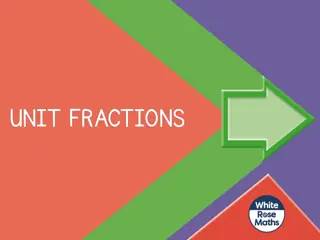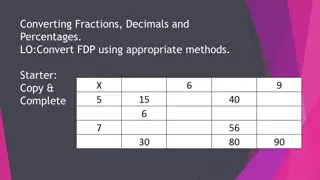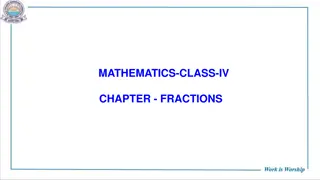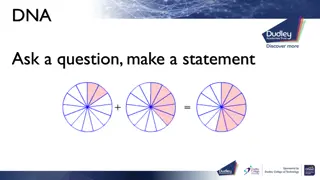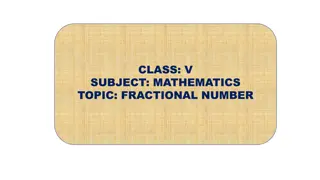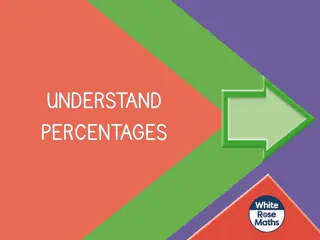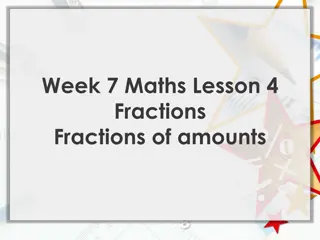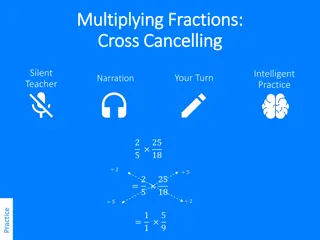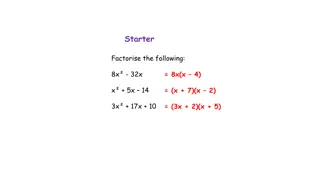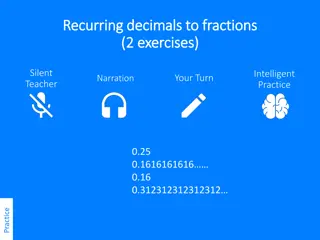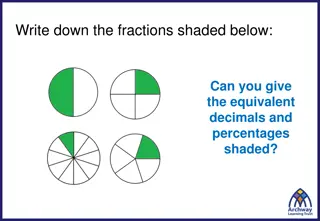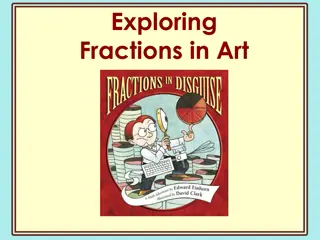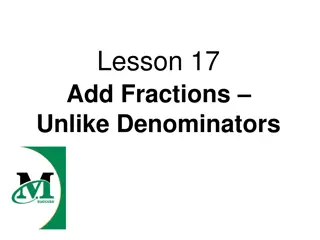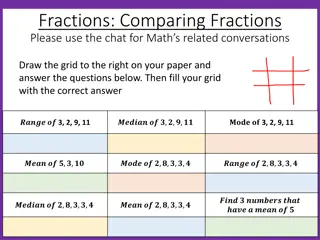Introduction to Fractions: Equal Parts Explanation
Fractions represent equal parts of a whole, which can be visualized through various shapes and examples. Understanding halves, thirds, fourths, and further divisions helps in grasping the concept of fractions. Explore how shapes are divided into equal parts and how fractions form a whole. Recognize fractions not only in shapes but also in groups of objects.
Download Presentation

Please find below an Image/Link to download the presentation.
The content on the website is provided AS IS for your information and personal use only. It may not be sold, licensed, or shared on other websites without obtaining consent from the author.If you encounter any issues during the download, it is possible that the publisher has removed the file from their server.
You are allowed to download the files provided on this website for personal or commercial use, subject to the condition that they are used lawfully. All files are the property of their respective owners.
The content on the website is provided AS IS for your information and personal use only. It may not be sold, licensed, or shared on other websites without obtaining consent from the author.
E N D
Presentation Transcript
Fractions An Instructional Power Point by The Curriculum Corner
Equal Parts To learn about fractions first you need to understand that they are Equal parts of a whole. There are many different ways a whole can be divided into equal parts. Take a look at the shapes as they appear . Notice all of them are divided into parts that are the same size.
Equal Parts Look at the following shapes as they appear. Tell whether or not they are divided into Equal parts and discuss why.
Equal Parts Shapes can be divided into any number of equal parts. For each shape that appears discuss how many equal parts you see .
Equal Parts We talk about a shape divided into two equal parts as being divided into halves. half half
Equal Parts We talk about a shape divided into Three equal parts as being divided into thirds. third third third
Equal Parts We talk about a shape divided into four equal parts as being divided into fourths. fourth fourth fourth fourth
Equal Parts The rest follow a similar pattern. fifths sixths Etc . sevenths
Equal Parts If we put all the fractional parts together we get the whole. 3 parts shaded = = 1 whole 3/3
Equal Parts When thinking about fractions, the whole doesn t always need to be a shape. The whole might be a Group of things. Take a look at the groups of cubes. Each individual cube is one equal part of the whole group.
Equal Parts Fractions are the same with Groups. 10/10 of the cubes are GREEN, so the whole group is green.
Fractions on a Number Line We can also think about fractions as numbers on a number line that are in between the whole numbers (1, 2, 3 ). 2 1 0
Fractions on a Number Line When using a number line we think of the space between two numbers as one whole part divided into smaller equal parts. In this example the space between 1 and 2 is divided into four equal parts so the fractions look like this in between those numbers: 1 0 (4/4) 1 4 2 4 3 4
Fractions When we talk about Fractions we are talking about any number of the equal parts of the whole. We might only talk about One equal part. Look at the colored parts of these examples:
Fractions We also might talk about more than one of the equal parts. Look at the colored parts of these examples. Discuss how many equal parts are shaded in each one.
Fractions When we write the numbers to show a fraction we put the number of Equal Parts in the whole on the BOTTOM. 2 = 1 3 3 equal parts
Fractions The bottom number is called the denominator. Denominator
Fractions We put the Number of parts that we are wanting to Represent on the TOP. 2 = 1 3 1 part shaded
Fractions The top number is called the numerator. Numerator
Fraction Practice Let s practice by looking at some pictures and naming the fraction they represent. What would be the Fraction for this shape?
Fraction Practice The fraction would be 1/4 because One part is shaded out of Four equal parts.
Fraction Practice Here is another one. What would be the Fraction for this shape?
Fraction Practice The fraction would be 2/6 because TWo parts are shaded out of six equal parts.
Fraction Practice Here is another one using a group. What would be the Fraction of GREEN cubes in this group?
Fraction Practice The fraction would be 3/7 because Three out of the sEVEN cubes are GREEN.
Fraction Practice Here is another one using the same group. What would be the Fraction of PINK cubes in this group?
Fraction Practice The fraction would be 4/7 because Four out of the sEVEN cubes are PINK.
Fraction Practice Here is another one using a number line. What would be the Fractions in between the two numbers? (Hint: Count how many parts the space is divided into.) 1 0
Fraction Practice The space is divided into 8 equal parts. 1 1 8 2 8 3 8 4 8 5 8 6 8 7 8 0 (8/8)
Fraction Practice Think you ve got it? Now practice these with your class. What would be the Fraction for the shaded parts of this shape?
Fraction Practice What would be the Fraction for the shaded parts of this shape?
Fraction Practice What would be the Fraction for the shaded parts of this shape?
Fraction Practice What would be the Fraction for the GREEN blocks in this group?
Fraction Practice What would be the Fraction for the PINK blocks in this group?
Fraction Practice What would be the Fractions in between the two numbers? 1 0
Fraction Practice What would be the Fractions in between the two numbers? 1 0




